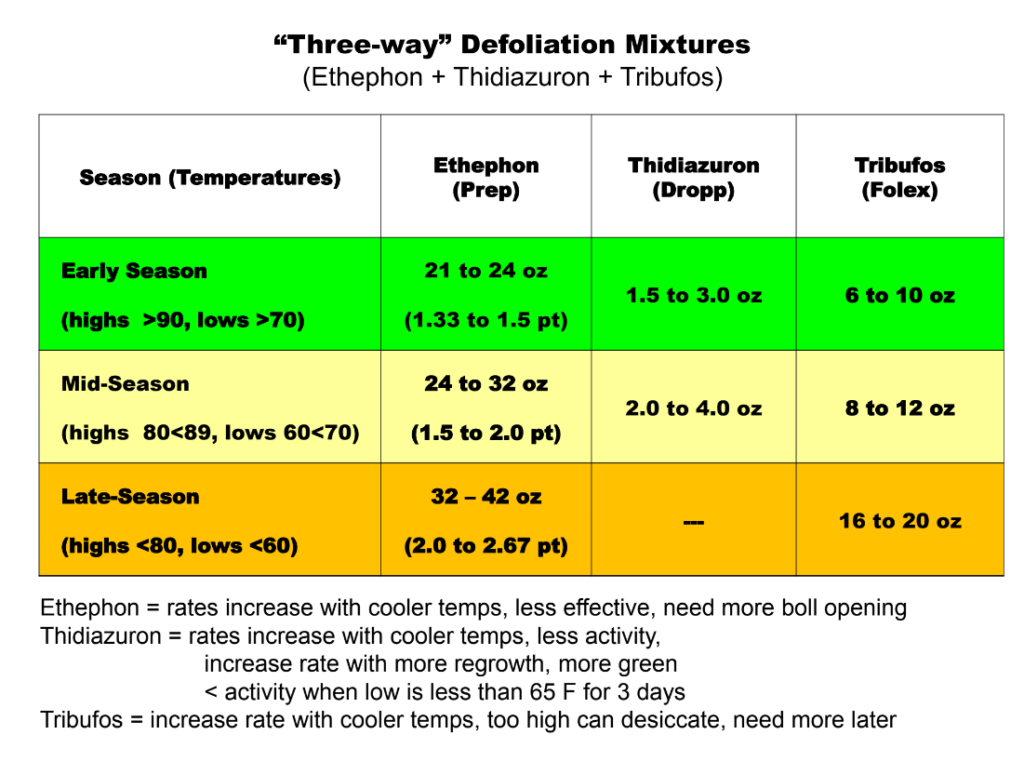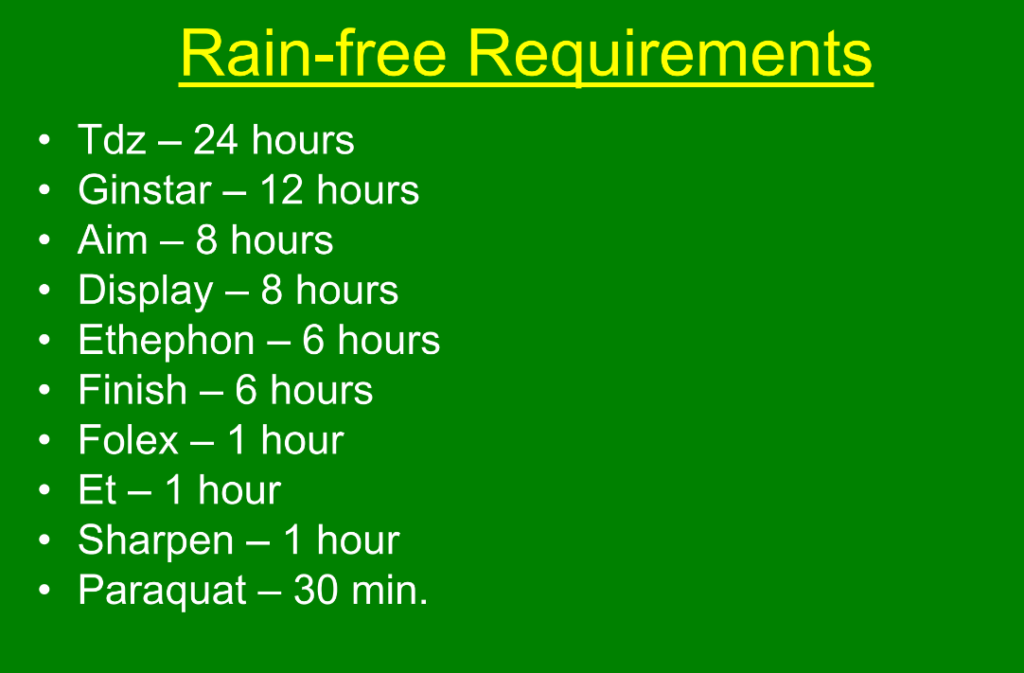It has been an interesting week in Colquitt County agriculture. The illustration below show the rainfall totals for the last 2 weeks for Colquitt County and the 5 day forecast for Moultrie. Peanut hull maturity clinics this week have been busy. Georgia 06G have been running 140 to 145 days to maturity. Growers need to keep an eye on vine condition and how that may impact digging. Dr. Bob has some comments below on late season disease control in peanut.



Points to Consider for Late-Season Disease Control in Peanuts
Bob Kemerait, UGA
Late-season disease recommendations for a peanut crop are often confusing. Reasons for this
include A) digging/harvest dates are not “set in stone”, B) the incidence of one disease versus
another affects choice of fungicides, C) disease can be cryptic, as in the case of underground
white mold, D) there are a number of fungicide options that can be deployed, and E)
approaching rains can make it necessary to quickly change management plans. While there
may not be a single “best” recommendation, some solutions are better than others. These
solutions have three things in common: a) timeliness, b) use of the right products (emphasis
that there is often more than one “right” product), and c) use of the right products at the right
rates. Late-season management decisions are more important now than they ever have been
as much of Georgia’s peanut crop remains in the ground for nearly 150 days. Our historic
“spray every 14 days for a total of 7 sprays” may not go the distance anymore.
Growers often request advice on adjusting digging dates based upon disease in the field.
Generally, it is best to wait until harvest maturity is reached in order to assure maximum grade,
rather than digging the peanuts early. For example, though tomato spotted wilt may be severe
in a field in 2022, I generally recommend waiting until harvest maturity to dig the peanuts,
unless other diseases, like white mold, are “piggy-backing” on top of the plants already affected
by the tomato spotted wilt. However, where defoliation from leaf spot is severe, as it is in
some field now, then it may be critical to digging earlier than planned in order to protect yield.
Georgia-06G can withstand defoliation of 50-60% IF digging is NOT delayed past maturity. Any
unexpected delays in digging will result in yield losses. Where white mold is severe, for
example greater than 50% incidence, the grower should consider digging early. Significant
defoliation from leaf spot diseases and severe outbreaks of white mold can increase digging
losses by weakening peg-strength.
NOTE: A critical consideration for choice of fungicides late in the season is that pre-harvest
intervals (PHI) vary among fungicides. For example, Alto has a 30-day PHI, and Elatus and
Convoy have 40-day PHI, compared to 14-day PHI for other fungicides such as Provost Silver
and Fontelis. Growers must always check the label to make sure on all of these.
Below are some typical situations that peanut growers may find themselves in and
suggestions for control:
Grower is 4 or more weeks away from harvest and currently has excellent disease control.
• Suggestion – I recommend the grower apply at least one more fungicide for leaf spot
control with an inexpensive white mold material mixed with it, for good measure. It is
generally helpful to use a mix of a protectant leaf spot fungicide (like chlorothalonil)
mixed a leaf spot fungicide with some curative activity (e.g., Alto, Domark, Topsin) for
best protection.
• Suggestion – Given the low cost of tebuconazole, the grower may consider applying a
tank-mix of tebuconazole + chlorothalonil for added insurance of white mold and leaf
spot.
o NOTE 1: If white mold is not an issue, then the grower may stick with a leaf spot
spray only.
o Note 2: If grower has planted Georgia-06G or Georgia-12Y and the plants are
leaf spot-free at 4 weeks prior to the anticipated digging date, an additional
fungicide application for leaf spot may not be needed if grower is willing to
watch/scout the field for other disease, for example peanut rust, and put a
fungicide out if harvest is unexpectedly delayed, as with the approach of a
hurricane.
Grower is 4 or more weeks away from harvest and has disease problems in the field.
• If the problem is with leaf spot – Grower should insure that any fungicide applied has
systemic/curative activity. If a grower wants to use chlorothalonil, then they would mix
a product like thiophanate methyl (Topsin M) or cyproconazole (Alto), with the
chlorothalonil. Others may consider applying Priaxor, if they have not already applied
Priaxor twice earlier in the season. Provost Silver from Bayer Crop Science has become
a “go to” product for helping to protect peanuts from leaf spot diseases late in the
season. Provost Silver is NOT a “silver bullet” but it has performed very well. A tank-mix
of Provysol + tebuconazole may also be appropriate.
• If the problem is white mold – Grower should continue with fungicide applications for
management of white mold. If they have completed their regular white mold program,
then they should extend the program, perhaps with a Fontelis, Provost Silver, or
tebuconazole/chlorothalonil mix. If the grower is unhappy with the level of control from
their fungicide program, then we can offer alternative fungicides to apply. Where white
mold AND leaf spot are late-season problem, then adding a little extra to the Fontelis for
additional leaf spot control may be beneficial.
• If the problem is underground white mold – Underground white mold is difficult to
control. Applying a white mold fungicide ahead of irrigation or rain, or applying at night,
can help to increase management of this disease.
Grower is no more than 3 weeks away from projected harvest and does not currently have a
disease issue.
• Good news! This grower should be good-to-go for the remainder of the season and no
more fungicides are required. SEE NOTE BELOW ABOUT HURRICANES
Grower is 3 or fewer weeks away from harvest and has a problem with disease.
• If leaf spot is a problem and 2-3 weeks away from harvest, a last leaf spot fungicide
application may be beneficial. If leaf spot is too severe (more than 25% defoliation
already occurs), then a last application will not help. Tank mixing chlorothalonil with a
systemic fungicide, like thiophanate methyl, Domark, or other appropriate systemic
fungicide, could be beneficial.
• If white mold is a problem and harvest is 3 weeks away, then it is likely beneficial to
apply a final white mold fungicide. If harvest is 2 weeks or less away, then it is unlikely
that a fungicide will be of any benefit.
o NOTE: If harvest is likely to be delayed by threat from a hurricane or tropical
storm, then the grower may reconsider recommendations for end-of-season
fungicide applications.
Finishing “strong” in the 4th quarter of the 2022 peanut season is important. Finishing “strong”
means timely applications, ahead of rains or storms if necessary,using the right fungicide
combination at the right rate. Your yield depends on it.
Cotton Defoliation… The Colquitt County Cotton Defoliation was very well attended this past week. Dr. Camp Hand, UGA Cotton Agronomist, educated growers on cotton defoliation. The “three way rates” are below.

I have been getting a question or two about rainfree periods for cotton defoliants.

Handouts about cotton defoliation was provided at the meeting. The first file is cotton defoliation recommendations from the UGA Pest Management Handbook. The second file is the publication “Cotton Defoliation in Georgia.”

The National Education Center for Agricultural Safety (NECAS) has daily webinars on important topics including;
Monday, September 19, 2022 – Tractor Safety & Rural Roadway Safety
Tuesday, September 20, 2022 – Overall Farmer Health
Wednesday, September 21, 2022 – Safety & Health for Youth in Agriculture
Thursday, September 22, 2022 – Confined Spaces
Friday, September 23, 2022 – Safety & Health for Women in Agriculture
Please use the link below to access these daily topics of focus and other safety information.
https://www.necasag.org/nationalfarmsafetyandhealthweek/
We also harvested a corn plot this past week and hopefully will have the results in the near future.
Have a great weekend.
Jeremy M. Kichler
Colquitt County Extension Coordinator

